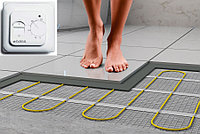Second, note the length, width, and height of the electric and telephone transformers and junction boxes. Then count the number of bricks or pieces of siding there are between the ground and the point where the wires attach to the house. Third, locate where the utilities enter the house. Third, establish the point where the wires attach to the house by using the baseline method of measuring (Figure 6-32). Figure 6-32
Record where wires attach to the house. With a house that has a basement, a close inspection of the basement wall usually reveals where this occurs. This survey should be done before on-site measuring so that measurements can be taken of the markings. The preceding method for locating underground utilities is the most reliable and should be followed whenever possible. Because they cannot be seen, underground utilities are difficult to locate and are a safety hazard if they are cut or punctured. However, when this process is not feasible or when it is necessary to augment the information it provides, then the following steps should be taken. It is absolutely essential to accurately locate utility lines for safety during construction, future maintenance of the utilities, and layout of the proposed design. This information may be difficult to find out, although contacting the various utility companies is a recommended place to start. In the case of electric or telephone lines, there may be transformers, junction boxes, or other metal containers where these utilities originate. Underground Utilities Underground utilities almost always include gas, water, and sewer. For gas and water lines, there should be shut-off valves located at or just below the ground’s surface somewhere on the site or in the street right-of-way. First, locate utility poles on or near the site by determining their position in relation to the property corners or by triangulation from two nearby corners of the house. Some utility lines are above ground and are fairly easily to locate. Figure 6-33
Locate the low point of the utility line. Fourth, estimate the height of the wires where they attach to the house by using the same method for approximating the height of the wires on the utility pole (Figure 6-31). The height of the low point is found with the same method previously described for estimating heights (Figure 6-33). The plan location of the low point can be determined by measuring along the wire or by triangulation. In addition, underground utilities may comprise electric, telephone, and/or cable, especially in neighborhoods developed in the past 25 years. The depths of the gas line, telephone wire, and cable are especially critical because they can easily be severed when digging into the ground. These features can be located with the triangulation method of measuring. First, locate the source of underground utilities along the property line, in the right-of-way, or in adjoining yards. Other utility lines are underground and potentially more problematic even though they cannot be seen.
Library builder
Articles about the repair, construction, interior design and landscaping, plumbing, electrical, waterproof wire, wire gas, building materials, construction machinery and equipment ...
Библиотека строительства - статьи о строительстве и ремонте © 2020
Frontier Theme



